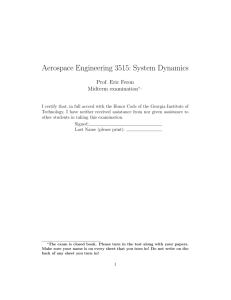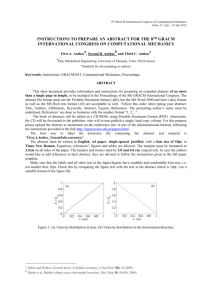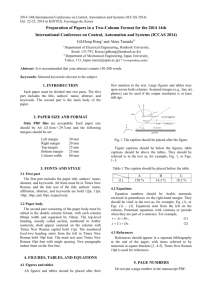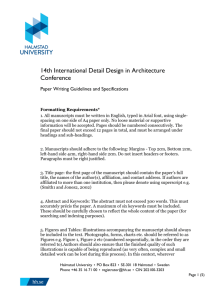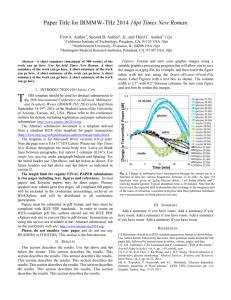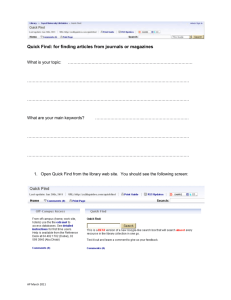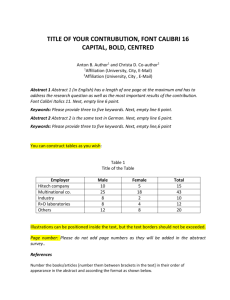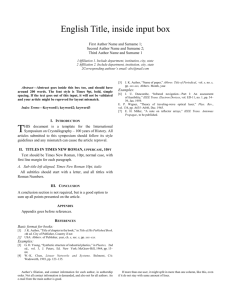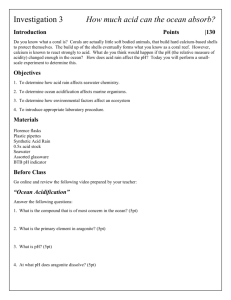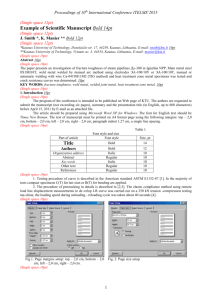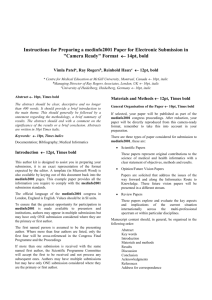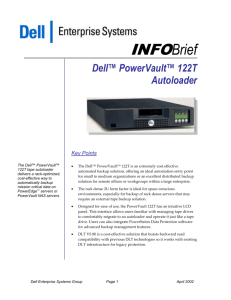Template For The Preparation Of Manuscript
advertisement
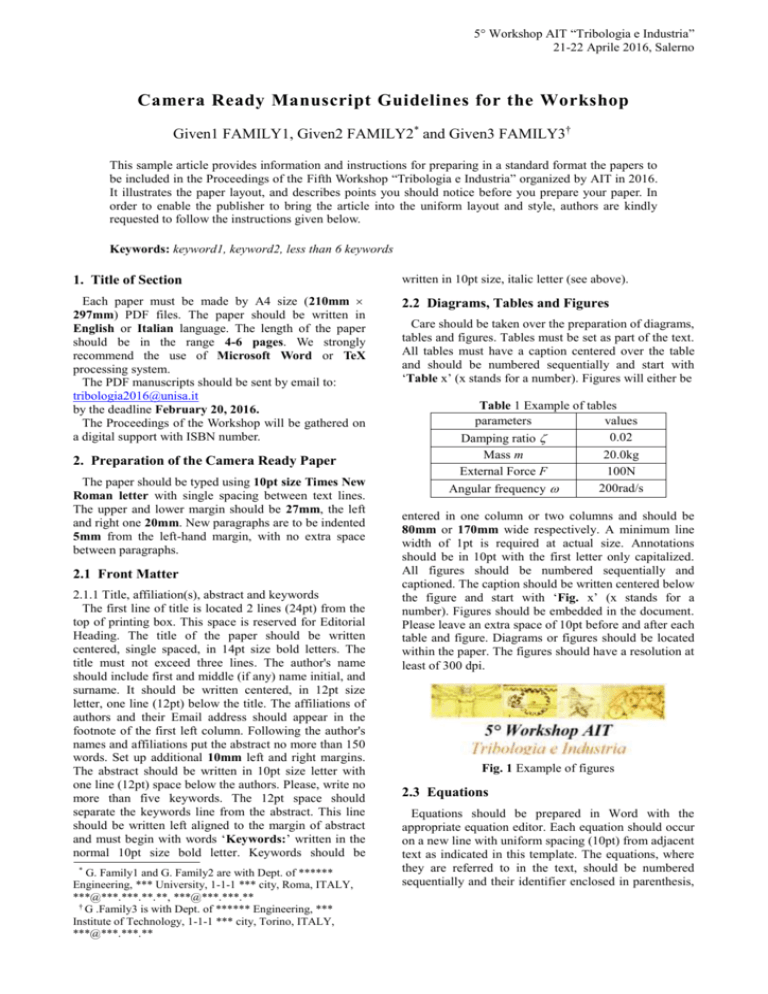
5° Workshop AIT “Tribologia e Industria” 21-22 Aprile 2016, Salerno Camera Ready Manuscript Guidelines for the Workshop Given1 FAMILY1, Given2 FAMILY2* and Given3 FAMILY3† This sample article provides information and instructions for preparing in a standard format the papers to be included in the Proceedings of the Fifth Workshop “Tribologia e Industria” organized by AIT in 2016. It illustrates the paper layout, and describes points you should notice before you prepare your paper. In order to enable the publisher to bring the article into the uniform layout and style, authors are kindly requested to follow the instructions given below. Keywords: keyword1, keyword2, less than 6 keywords 1. Title of Section written in 10pt size, italic letter (see above). Each paper must be made by A4 size (210mm 297mm) PDF files. The paper should be written in English or Italian language. The length of the paper should be in the range 4-6 pages. We strongly recommend the use of Microsoft Word or TeX processing system. The PDF manuscripts should be sent by email to: tribologia2016@unisa.it by the deadline February 20, 2016. The Proceedings of the Workshop will be gathered on a digital support with ISBN number. 2.2 Diagrams, Tables and Figures 2. Preparation of the Camera Ready Paper The paper should be typed using 10pt size Times New Roman letter with single spacing between text lines. The upper and lower margin should be 27mm, the left and right one 20mm. New paragraphs are to be indented 5mm from the left-hand margin, with no extra space between paragraphs. 2.1 Front Matter 2.1.1 Title, affiliation(s), abstract and keywords The first line of title is located 2 lines (24pt) from the top of printing box. This space is reserved for Editorial Heading. The title of the paper should be written centered, single spaced, in 14pt size bold letters. The title must not exceed three lines. The author's name should include first and middle (if any) name initial, and surname. It should be written centered, in 12pt size letter, one line (12pt) below the title. The affiliations of authors and their Email address should appear in the footnote of the first left column. Following the author's names and affiliations put the abstract no more than 150 words. Set up additional 10mm left and right margins. The abstract should be written in 10pt size letter with one line (12pt) space below the authors. Please, write no more than five keywords. The 12pt space should separate the keywords line from the abstract. This line should be written left aligned to the margin of abstract and must begin with words ‘Keywords:’ written in the normal 10pt size bold letter. Keywords should be * G. Family1 and G. Family2 are with Dept. of ****** Engineering, *** University, 1-1-1 *** city, Roma, ITALY, ***@***.***.**.**, ***@***.***.** † G .Family3 is with Dept. of ****** Engineering, *** Institute of Technology, 1-1-1 *** city, Torino, ITALY, ***@***.***.** Care should be taken over the preparation of diagrams, tables and figures. Tables must be set as part of the text. All tables must have a caption centered over the table and should be numbered sequentially and start with ‘Table x’ (x stands for a number). Figures will either be Table 1 Example of tables parameters values 0.02 Damping ratio Mass m 20.0kg External Force F 100N 200rad/s Angular frequency entered in one column or two columns and should be 80mm or 170mm wide respectively. A minimum line width of 1pt is required at actual size. Annotations should be in 10pt with the first letter only capitalized. All figures should be numbered sequentially and captioned. The caption should be written centered below the figure and start with ‘Fig. x’ (x stands for a number). Figures should be embedded in the document. Please leave an extra space of 10pt before and after each table and figure. Diagrams or figures should be located within the paper. The figures should have a resolution at least of 300 dpi. Fig. 1 Example of figures 2.3 Equations Equations should be prepared in Word with the appropriate equation editor. Each equation should occur on a new line with uniform spacing (10pt) from adjacent text as indicated in this template. The equations, where they are referred to in the text, should be numbered sequentially and their identifier enclosed in parenthesis, 5° Workshop AIT “Tribologia e Industria” 21-22 Aprile 2016, Salerno right justified as indicated below. The punctuation should be used in equations as they were regular sentences. Example : some text EI P 2 scientific content. Abbreviations should be spelt out in full the first time they appear and their abbreviated form included in brackets immediately after. Do not use more than three level depth of headings. 2 2w 0 x 2 d x . L (1) Please pay attention that all variable references in text must be written the same style as in displayed equations. The citation of figure(s), reference(s) and equation(s) have to be abbreviated as Fig. x; Ref. [x]; Eq. (x) or, in plural form, as Figs. x,y; Refs. [x,y]; Eqs. (x,y) - where x, y stand for a number. Above phrases are typed in full word when they appear as the first word of sentence. Citation of table(s) is always written in full word - Table x or Tables x, y. Please be consistent in the use of capital letters, abbreviations and punctuation. 2.4 Units Please use SI – units throughout the paper. 3.2 Paper Length The paper, including the title page, figures, tables must be 4-6 pages. 4. References The papers in the reference list must be cited in the text. In the text the citation should appear in square brackets “[ ]”, as in, for example, ‘…In Ref. [2] an investigation of the stability and chaos for wheel suspension was presented....” In the Reference list the font size should 9pt. Author names should be terminated by a ‘full stop’. The citation number should be enclosed in brackets. The book titles should be followed by a ‘full stop’. References 3. General Style Preferences [1] G.Family1, G.Family2 3.1 Style of Writing [2] Given Family, How to Measure the Friction, Springer- Papers are accepted on the basis that they match high international standards of scientific writing. The author himself is responsible for the correctness of the and G.Family3, Tribology International, Vol. 50, No.2, pp. 101-106, 2010. Verlag, Berlin and New York, 2015.
